Development of Stochastic Fatigue Model of Reinforcement for Reliability of Concrete Structures
Abstract
1. Introduction
2. Materials and Methods
2.1. Test Data
2.2. Statistical Analysis of Fatigue Data of Steel Reinforcing Bars
2.3. Bootstrap Method
2.4. Bayesian Inference with Markov Chain Monte Carlo Implementation
- Select initial parameter vector
- Iterate as follows for
- a.
- Create a new trial position where is randomly sampled from the jumping distribution
- b.
- Create the Metropolis ratio.
- 3.
- Accept a new sample if:
3. Results of Uncertainty Modelling
4. Case Study: Crêt De l’Anneau Viaduct
4.1. Limit State Equation
- t indicates time 0 < t < TL in years,
- is the service life time of the structure,
- is modelling the ratio of design parameters, here the section modulus of the deck slab,
- is the stress range for the ith load bin.
4.2. Reliability Analysis
4.3. Reliability Results
5. Conclusions
Author Contributions
Funding
Acknowledgments
Conflicts of Interest
References
- Hansen, L.P.; Heshe, G. Static, Fire and Fatigue Tests of Ultra High-Strength Fibre Reinforced Concrete and Ribbed Bars. J. Nord. Concr. Res. 2001, 26, 17–37. [Google Scholar]
- Sørensen, J. Notes in Structural Reliability Theory and Risk Analysis; Aalborg University: Aalborg, Denmark, 2011. [Google Scholar]
- Madsen, H.O.; Krenk, S.; Lind, N.C. Methods of Structural Safety; Prentice-Hall: Upper Saddle River, NJ, USA, 1986. [Google Scholar]
- Ditlevsen, O.; Madsen, H. Structural Reliability Methods; Wiley: Hoboken, NJ, USA, 1996. [Google Scholar]
- Faber, M.H. Risk Assessment in Engineering (Principles, System Representation & Risk Criteria). Available online: https://www.jcss.byg.dtu.dk/-/media/Subsites/jcss/english/publications/risk_assessment_in_engineering/jcss_riskassessment.ashx?la=da&hash=F4BD53E6E9C2AD6242FD54762719D55BD251A995 (accessed on 15 November 2019).
- Kaplan, S.; Garrick, B.J. On the Quantitative Definition of Risk. Risk Anal. 1981, 1, 11–27. [Google Scholar] [CrossRef]
- Modarres, M. Risk Analysis in Engineering: Techniques, Tools, and Trends; CRC Press: Boca Raton, FL, USA, 2006. [Google Scholar]
- Zio, E.; Baraldi, P.; Cadini, F. Basics of Reliability and Risk Analysis: Worked Out Problems and Solutions; World Scientific Publishing Co. Pte. Ltd.: Singapore, 2011. [Google Scholar]
- Zio, E. Introduction To The Basics Of Reliability And Risk Analysis [Elektronisk resurs]; World Scientific Publishing Co. Pte. Ltd.: Singapore, 2007. [Google Scholar]
- Chemweno, P.; Pintelon, L.; Muchiri, P.N.; Van Horenbeek, A. Risk assessment methodologies in maintenance decision making: A review of dependability modelling approaches. Reliab. Eng. Syst. Saf. 2018, 173, 64–77. [Google Scholar] [CrossRef]
- Aven, T.; Zio, E. Knowledge in Risk Assessment and Management; John Wiley & Sons: Hoboken, NJ, USA, 2018. [Google Scholar]
- Pham, H. Bayesian Inference for Probabilistic Risk Assessment; Springer: Berlin, Germany, 2005. [Google Scholar]
- Fenton, N.; Neil, M. Risk Assessment and Decision Anlysis with Bayesian Networks; CRC Press: Boca Raton, FL, USA, 2013. [Google Scholar]
- Singpurwla, N.D. Reliability and Risk. A Bayesian Perspective; John Wiley & Sons, Ltd.: Chichester, UK, 2006. [Google Scholar]
- Aven, T. Risk assessment and risk management: Review of recent advances on their foundation. Eur. J. Oper. Res. 2016, 253, 1–13. [Google Scholar] [CrossRef]
- Lair, J.; Rissanen, T.; Sarja, A. Methods for Optimisation and Decision Making in Lifetime Management of Structures. 2004. Available online: https://www.scribd.com/document/342349363/METHODS-FOR-OPTIMISATION-AND-DECISION-MAKING-IN-LIFETIME-MANAGEMENT-OF-STRUCTURES (accessed on 15 November 2019).
- Vrouwenvelder, A.; Holicky, B.M.; Tanner, C.P.; Lovegrove, D.R.; Canisius, E.G. Risk Assessment and Risk Communication in Civil Engineering. 2001. Available online: https://www.irbnet.de/daten/iconda/CIB14314.pdf (accessed on 15 November 2019).
- Bhattacharya, B. Risk and Reliability in Bridges. Innovative Bridge Design Handbook; Elsevier: Amsterdam, The Netherlands, 2016. [Google Scholar]
- Bahrebar, S.; Zhou, D.; Rastayesh, S.; Wang, H.; Blaabjerg, F. Reliability assessment of power conditioner considering maintenance in a PEM fuel cell system. Microelectron. Reliab. J. 2018, 88-90, 1177–1182. [Google Scholar] [CrossRef]
- Rastayesh, S.; Bahrebar, S.; Bahman, A.S.; Dalsgaard Sørensen, J.; Blaabjerg, F. Lifetime Estimation and Failure Risk Analysis in a Power Stage Used in Wind-Fuel Cell Hybrid Energy Systems. Electronics 2019, 8, 1412. [Google Scholar] [CrossRef]
- Rastayesh, S.; Long, L.; Dalsgaard Sørensen, J.; Thöns, S. Risk Assessment and Value of Action Analysis for Icing Conditions of Wind Turbines Close to Highways. Energies 2019, 12, 2653. [Google Scholar] [CrossRef]
- Màrquez-Dominguez, S. Reliability-Based Design and Planning of Inspection and Monitoring of OffshoreWind Turbines; Aalborg University: Aalborg, Denmark, 2013. [Google Scholar]
- Mankar, A.; Rastayesh, S.; Dalsgaard Sørensen, J. Sensitivity and Identifiability Study for Uncertainty Analysis of Material Model for Concrete Fatigue. In Proceedings of the 5th International Reliability and Safety Engineering Conference, Shiraz, Iran, 9–10 May 2018. [Google Scholar]
- Seber, G.; Wild, C. Non-Linear Regression; Wiley: Hoboken, NJ, USA, 1989. [Google Scholar]
- Rastayesh, S.; Bahrebar, S.; Blaabjerg, F.; Zhou, D.; Wang, H.; Dalsgaard Sørensen, J. A System Engineering Approach Using FMEA and Bayesian Network for Risk Analysis—A Case Study. Sustainability 2020, 12, 77. [Google Scholar] [CrossRef]
- Rastayesh, S.; Sønderkær Nielsen, J.; Dalsgaard Sørensen, J. Bayesian Network Methods for Risk-Based Decision Making for Wind Turbines. In Proceedings of the EAWE PhD Seminar on Wind Energy, Brussel, Belgium, 18–20 September 2018. [Google Scholar]
- Metropolis, N.; Ulam, S. The Monte Carlo method. J. Am. Stat. Assoc. 1949, 44, 335–341. [Google Scholar] [CrossRef] [PubMed]
- MC1990, FIB Model Code for Concrete Structures 1990; Ernst & Sohn: Berlin, Germany, 1993.
- MC2010, FIB Model Code for Concrete Structures 2010; Ernst & Sohn: Berlin, Germany, 2013.
- Høvik, S. DNV OS C 502, DNV OS C 502, Offshore Concrete Structures; DNVGL: Høvik, Norway, 2012. [Google Scholar]
- Rastayesh, S.; Mankar, A.; Sørensen, J.D. Comparative investigation of uncertainty analysis with different methodologies on fatigue data of rebars. In Proceedings of the 5th International Reliability and Safety Engineering Conference, Shiraz University, Shiraz, Iran, 9–10 May 2018. [Google Scholar]
- Lindley, D. Introduction to Probability and Statistics from a Bayesian Viewpoint, vol. 1+2; Cambridge University Press: Cambridge, UK, 1976. [Google Scholar]
- Efron, B. Bootstrap Methods: Another Look at the Jackknife. Ann. Stat. 1979, 7, 1–26. [Google Scholar] [CrossRef]
- Sin, G.; Gernaey, K.V. Data Handling and Parameter Estimation. In Experimental Methods in Wastewater Treatment; IWA Publishing: London, UK, 2016; Volume 281780404745. [Google Scholar]
- Alfredo, H.; Tang, W.H. Probability Concepts in Engineering: Emphasis on Applications in Civil & Environmental Engineering, 2nd ed.; Wiley: Hoboken, NJ, USA, 2007. [Google Scholar]
- Gelman, A.; Carlin, J.B.; Stern, H.S.; Dunson, D.B.; Vehtari, A.; Rubin, D. Bayesian Data Analysis; A Champman & Hall Book: New York, NY, USA, 2003. [Google Scholar]
- EN 1990, Eurocode 0: Basis for Structural Design; Cen: Brussels, Belgium, 2002.
- Hastings, W.K. Monte Carlo sampling methods using Markov chains and their applications. Biometrika 1970, 57, 97–109. [Google Scholar] [CrossRef]
- EN 1992-1-1, Eurocode 2: Design of Concrete Structures - Part 1-1: General Rules and Rules for Buildings; Cen: Brussels, Belgium, 2004.
- MCS. Surveillance du Viaduc du Crêt de l’Anneau par un Monitoring à Longue Durée; MSC: Lausanne, Switzerland, 2017. [Google Scholar]
- Mankar, A.; Rastayesh, S.; Dalsgaard Sørensen, J. Fatigue reliability analysis of Crêt de l’Anneau viaduct: A case study. Struct. Infrastruct. Eng. 2019. [CrossRef]
- Palmgren, A. Die lebensdauer von kugellagern (The life of ball bearings). Zeitschrift Des Vereins Deutscher Ingenieure 1924, 68, 339–341. [Google Scholar]
- Miner, M.A. Cumulative damage in fatigue. Am. Soc. Mech. Eng. J. Appl. Mech. 1945, 12, 159–164. [Google Scholar]
- Mankar, A.; Rastayesh, S.; Dalsgaard Sørensen, J. Fatigue Reliability analysis of Cret De l’Anneau Viaduct: A case study. In Proceedings of the IALCCE 2018, Ghent, Belgium, 18–31 October 2018. [Google Scholar]
- CEB 1988. Fatigue of Concrete Structures - State of Art Report; CEB: Zurich, Switzerland, 1989. [Google Scholar]
- Madsen, H.O.; Krenk, S.; Lind, N.C. Methods of Structural Safety; Dover Publications: New York, NY, USA, 2006. [Google Scholar]
- FERUM. Finite Element Reliability Using Matlab; University of California Berkeley: Berkeley, CA, USA, 2010. [Google Scholar]
- SIA-269, Existing Structures–Bases for Examination and Interventions; Swiss Society of Engineers and Architects: Zurich, Switzerland, 2016.
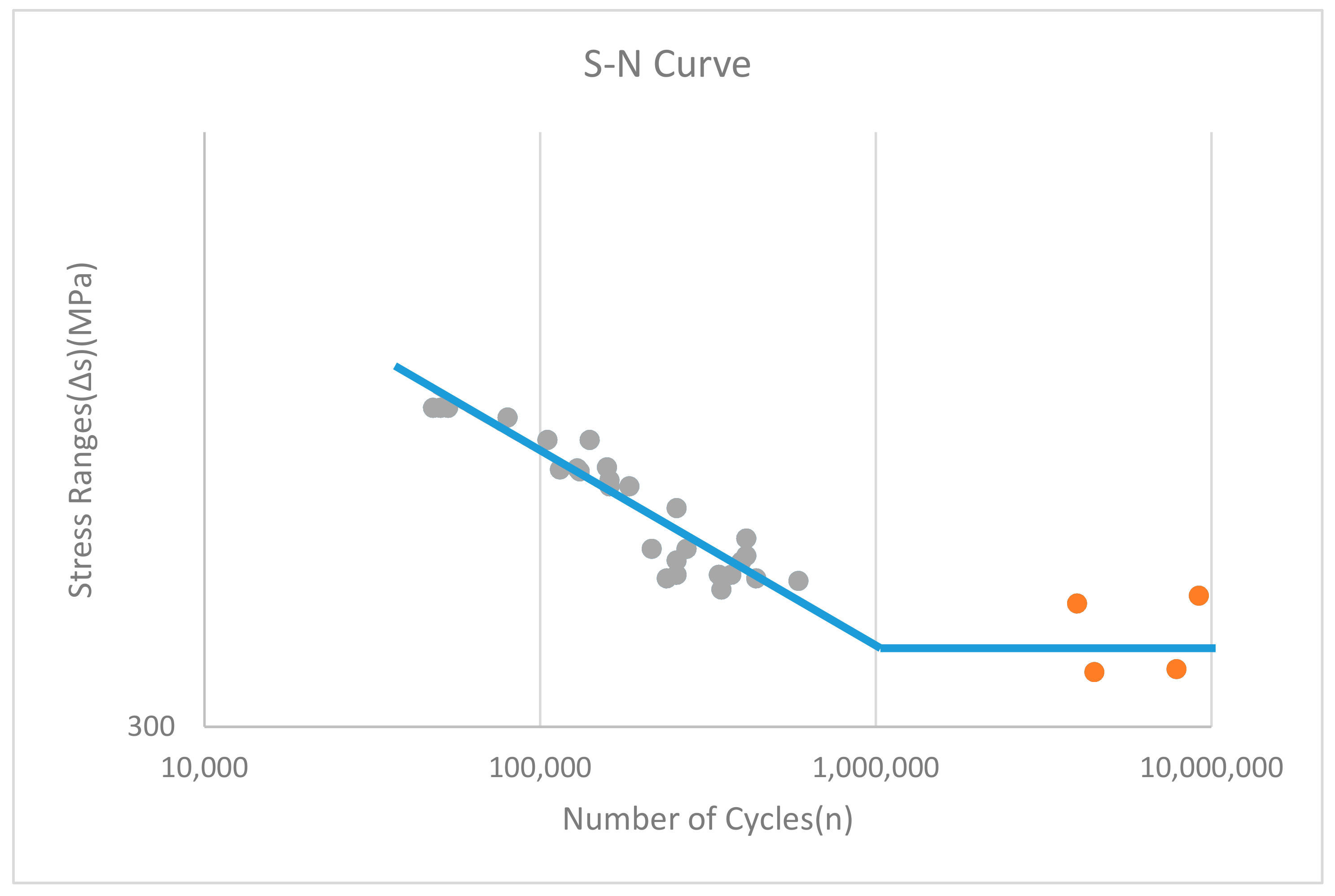
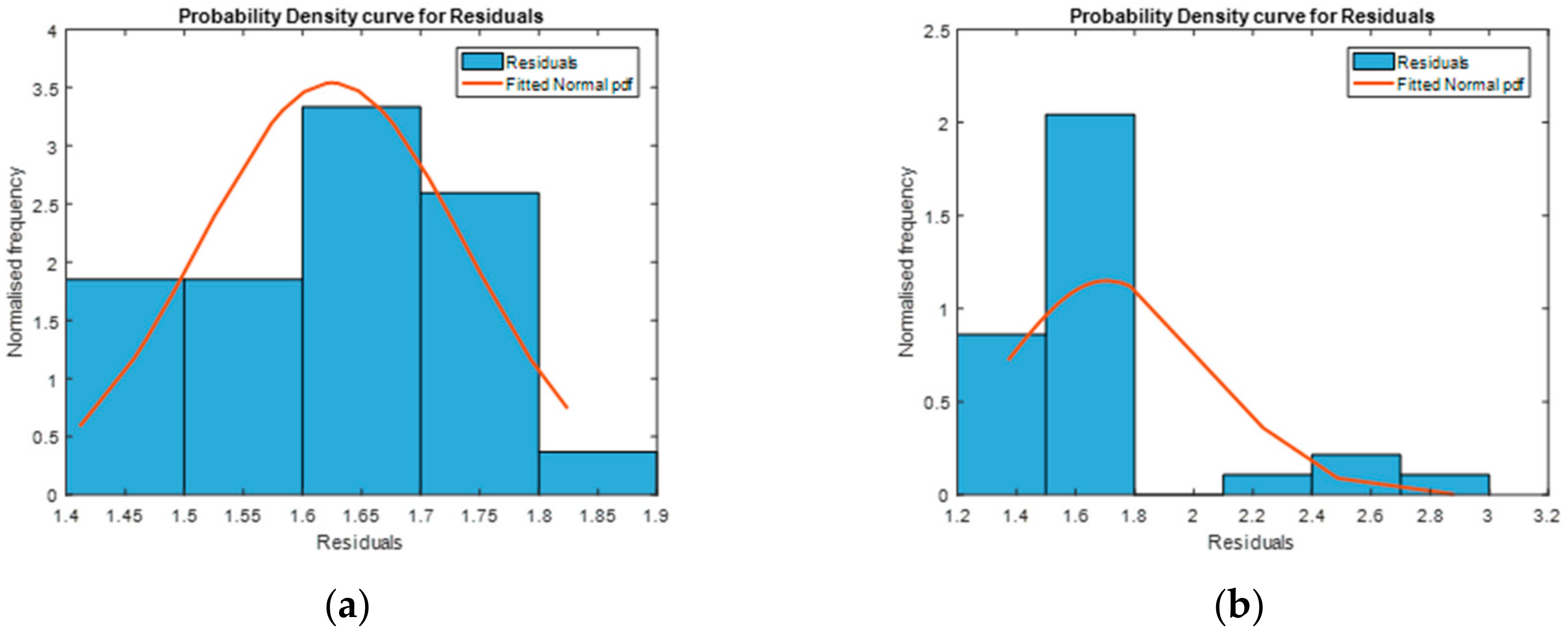
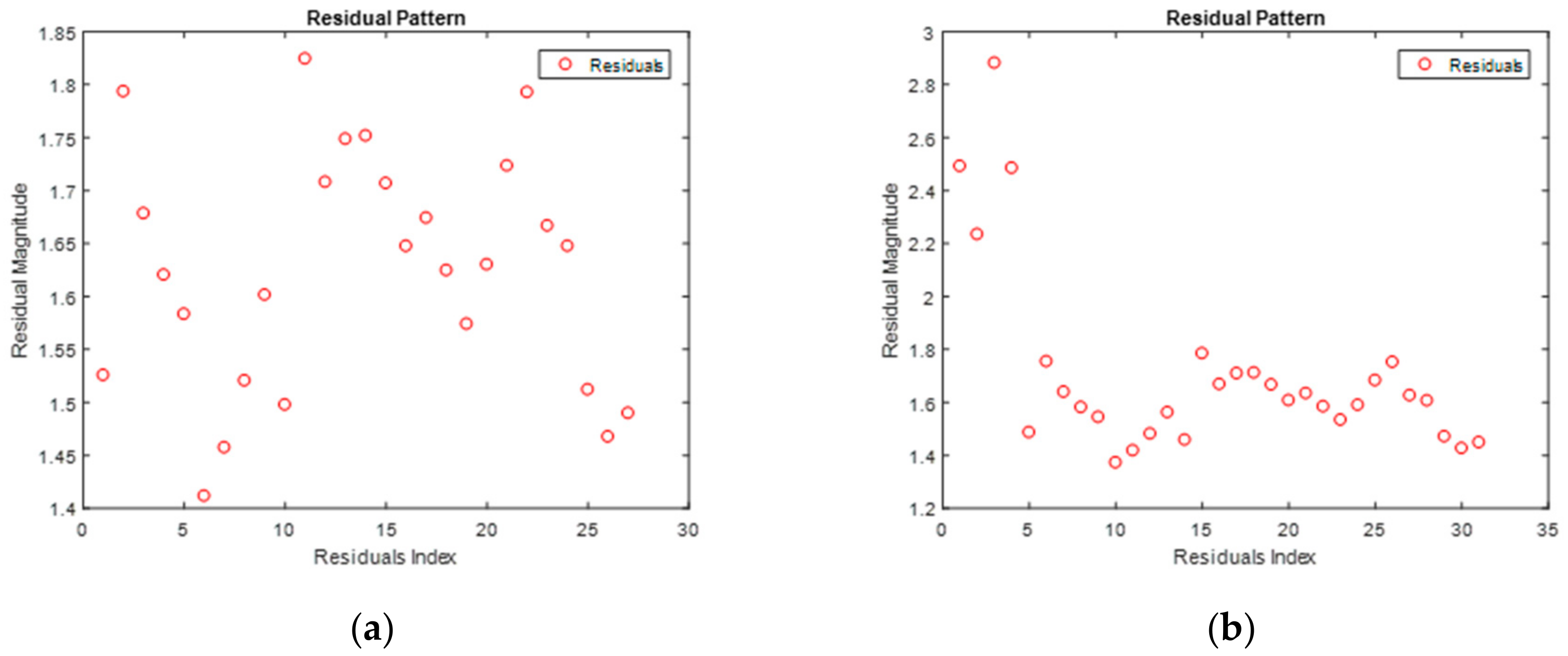
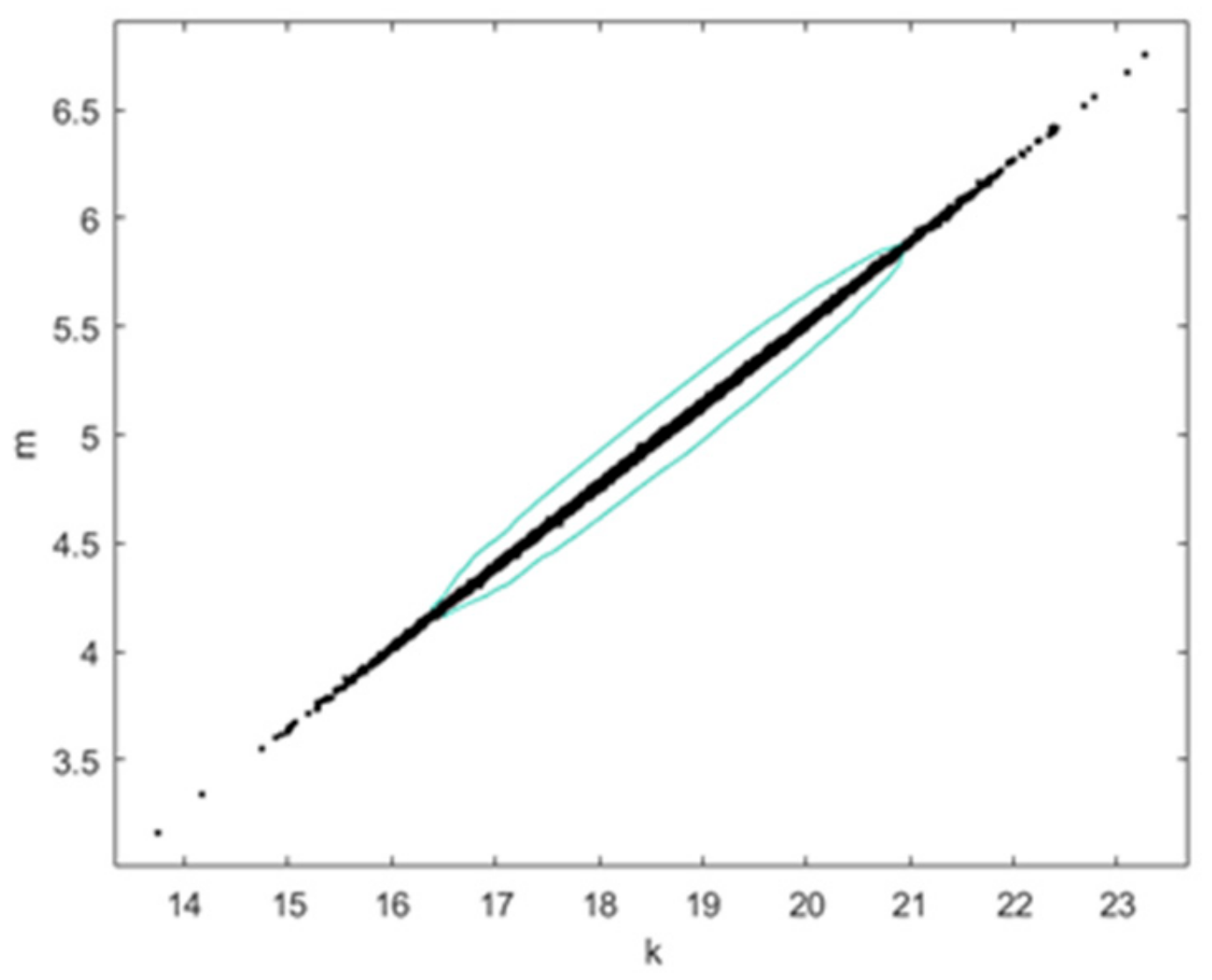

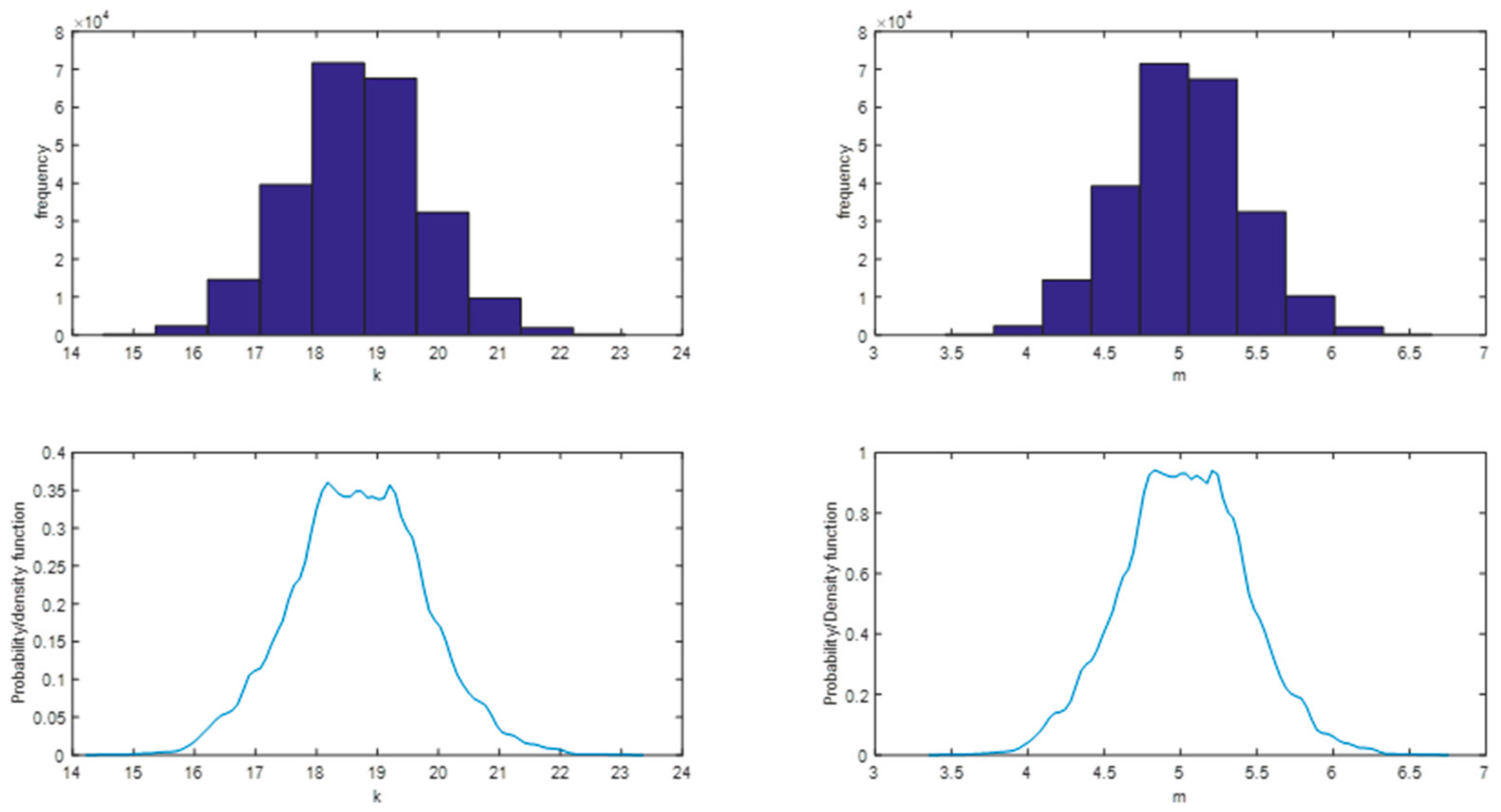
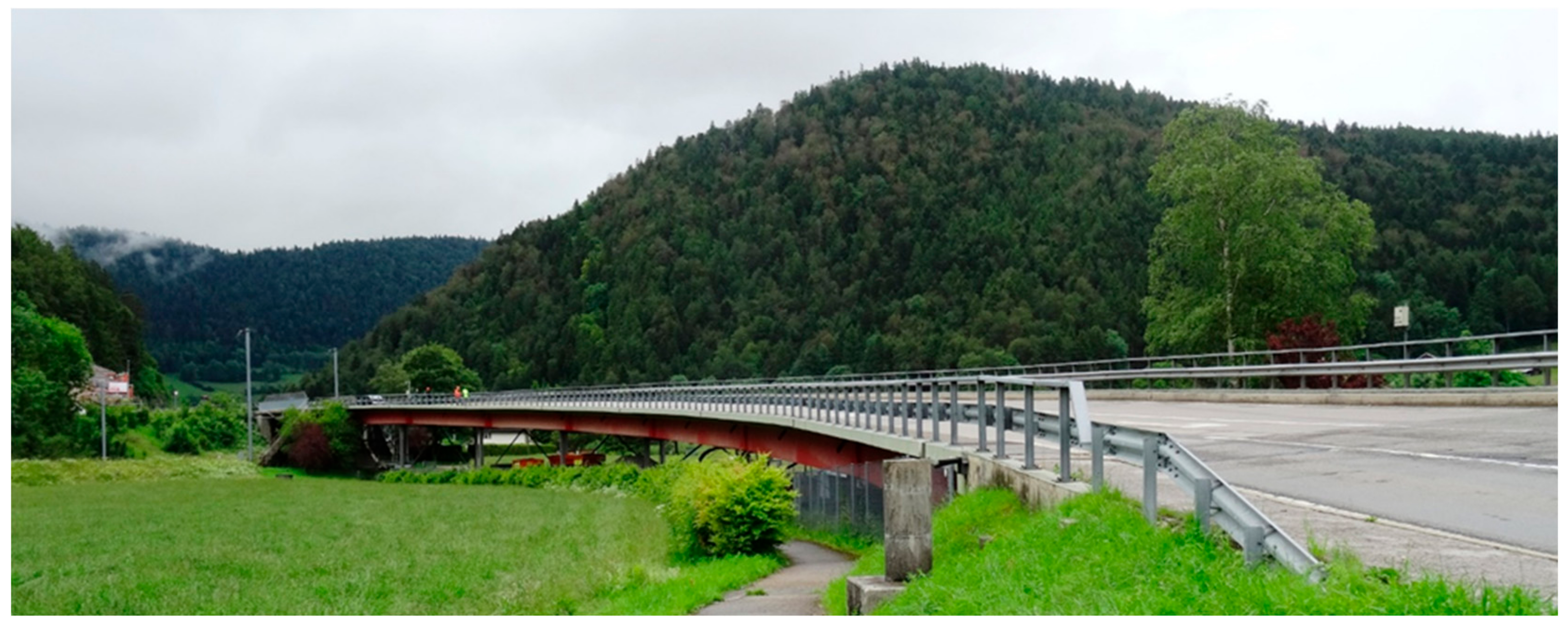
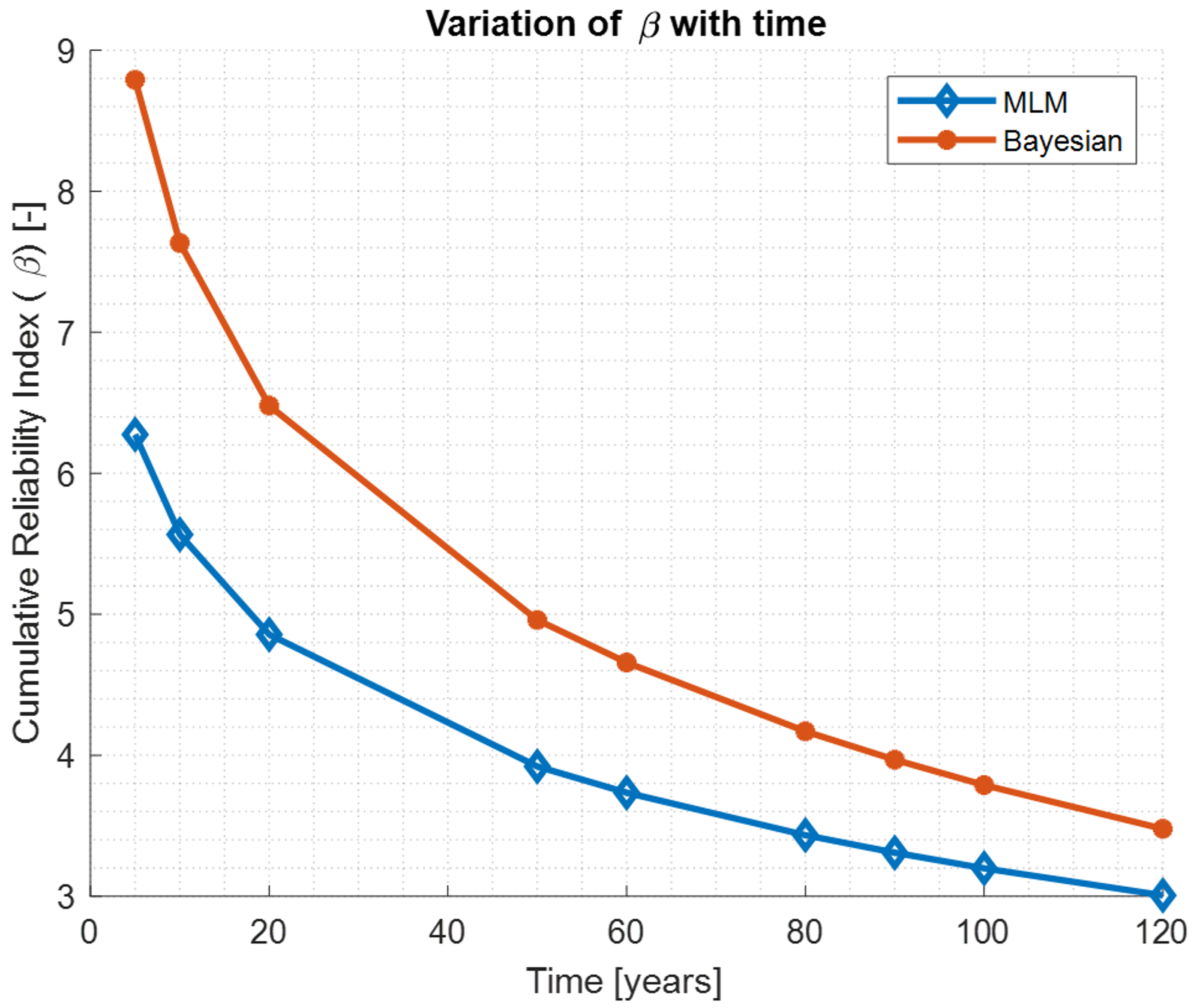
| Data Number (Index) | Number of Cycles to Failure | Stress Range [MPa] | Run-Out |
|---|---|---|---|
| 1 | 7,875,829 | 337 | 1 |
| 2 | 4,485,923 | 335 | 1 |
| 3 | 9,182,542 | 391 | 1 |
| 4 | 3,981,071 | 385 | 1 |
| 5 | 347,328 | 396 | 0 |
| 6 | 589,346 | 403 | 0 |
| 7 | 441,005 | 405 | 0 |
| 8 | 371,852 | 408 | 0 |
| 9 | 341,454 | 408 | 0 |
| 10 | 238,658 | 405 | 0 |
| 11 | 255,509 | 408 | 0 |
| 12 | 255,509 | 420 | 0 |
| 13 | 273,550 | 430 | 0 |
| 14 | 215,443 | 430 | 0 |
| 15 | 411,921 | 439 | 0 |
| 16 | 398,107 | 419 | 0 |
| 17 | 411,921 | 424 | 0 |
| 18 | 255,509 | 467 | 0 |
| 19 | 184,784 | 488 | 0 |
| 20 | 161,215 | 488 | 0 |
| 21 | 161,215 | 494 | 0 |
| 22 | 131,376 | 503 | 0 |
| 23 | 114,619 | 505 | 0 |
| 24 | 129,154 | 506 | 0 |
| 25 | 158,489 | 507 | 0 |
| 26 | 140652 | 536 | 0 |
| 27 | 105,250 | 536 | 0 |
| 28 | 80,113 | 561 | 0 |
| 29 | 53,201 | 572 | 0 |
| 30 | 48,026 | 572 | 0 |
| 31 | 50,547 | 572 | 0 |
| Parameter | Mean by MLM | Mean by Bayesian Approach | Standard Deviation by MLM | Standard Deviation by Bayesian Approach | Distribution | Remark |
|---|---|---|---|---|---|---|
| 0 | 0 | --- | --- | Normal | Error term | |
| 0.39 | 0.21 | 0.06 | 0.04 | Normal | Standard deviation of error term | |
| 18.77 | 18.72 | 0.07 | 0.05 | Normal | Location parameter in Wöhler curve | |
| Fixed to 5 | 5.03 | --- | 0.02 | Fixed/Deterministic | Slope of Wöhler curve | |
| 0.06 | 0.03 | Deterministic | Correlation coefficient between location and standard deviation of error |
| Parameter | Distribution | Mean | Standard Deviation | Remark |
|---|---|---|---|---|
| Lognormal | 1 | 0.30 | Model uncertainty related to PM Rule 1 | |
| Lognormal | 1 | 0.05 | Uncertainty in strain measurements | |
| Lognormal | 1 | 0.01 | Uncertainty in number of vehicles | |
| Normal | 18.77 | 0.07 | Location parameter in Wöhler curve | |
| Fixed | 5 | --- | Slope of Wöhler curve fixed to 5 2 | |
| Normal | 0 | Error term taken from Table 2 | ||
| Normal | 0.39/0.21 3 | 0.06/0.004 3 | Standard deviation of error term taken from Table 2 | |
| Deterministic | 0.06/0.003 3 | --- | Correlation coefficient between location and standard deviation of error taken from Table 2 |
| Annual Reliability Index at 120 Years | |
|---|---|
| 0.39 (MLM) | 3.90 |
| 0.20 (Bayesian) | 4.25 |
© 2020 by the authors. Licensee MDPI, Basel, Switzerland. This article is an open access article distributed under the terms and conditions of the Creative Commons Attribution (CC BY) license (http://creativecommons.org/licenses/by/4.0/).
Share and Cite
Rastayesh, S.; Mankar, A.; Dalsgaard Sørensen, J.; Bahrebar, S. Development of Stochastic Fatigue Model of Reinforcement for Reliability of Concrete Structures. Appl. Sci. 2020, 10, 604. https://doi.org/10.3390/app10020604
Rastayesh S, Mankar A, Dalsgaard Sørensen J, Bahrebar S. Development of Stochastic Fatigue Model of Reinforcement for Reliability of Concrete Structures. Applied Sciences. 2020; 10(2):604. https://doi.org/10.3390/app10020604
Chicago/Turabian StyleRastayesh, Sima, Amol Mankar, John Dalsgaard Sørensen, and Sajjad Bahrebar. 2020. "Development of Stochastic Fatigue Model of Reinforcement for Reliability of Concrete Structures" Applied Sciences 10, no. 2: 604. https://doi.org/10.3390/app10020604
APA StyleRastayesh, S., Mankar, A., Dalsgaard Sørensen, J., & Bahrebar, S. (2020). Development of Stochastic Fatigue Model of Reinforcement for Reliability of Concrete Structures. Applied Sciences, 10(2), 604. https://doi.org/10.3390/app10020604






